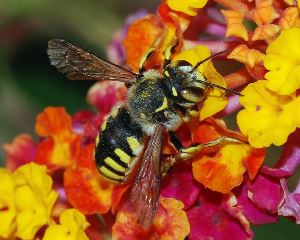![]() About one million insect species have been identified to date; however, many people believe that with this number we’re merely scratching the surface and there may exist five times as many species of this class in the world. Last year, Genome Biology started filling the gaps in our knowledge on these animals with the publication of only the second ever beetle genome.
About one million insect species have been identified to date; however, many people believe that with this number we’re merely scratching the surface and there may exist five times as many species of this class in the world. Last year, Genome Biology started filling the gaps in our knowledge on these animals with the publication of only the second ever beetle genome.
In our latest issue, Genome Biology adds two more pieces to this buzzing puzzle: Dr Kocher and colleagues report a draft genome of the halictid bee Lasioglossum albipes, and Dr Xiao and colleagues present a genome of the fig wasp Ceratosolen solmsi. Both these insects exhibit very different but equally fascinating lifestyles.

L. albipes is a socially polymorphic halictid bee, which in certain geographical regions lives in colonies, while in others as a solitary bee. Dr Kocher and colleagues’ analysis of this bee’s genome shows that a number of gene families are expanded in this species. They also demonstrate an accelerated evolution of genes associated with metabolism and nucleotide binding. Most interestingly, Dr Kocher and colleagues perform a comparative transcriptome analysis between a female bee from a colony and a solitary individual, and identify six genes that are undergoing a rapid divergence between these social forms. Intriguingly, one of these genes encodes a putative odorant receptor, which could indicate differences in the pheromone signaling systems of these two forms.
The fig wasp C. solmsi is a species that could not be more different. It is an obligate symbiont of one type of fig tree, but, while in other symbioses of this level of dependency the symbiont is transmitted to the host offspring (so-called vertical transmission), the fig wasp transfers horizontally: its females fly huge distances of up to 160 km to find yet another fig tree, in order to lay eggs in it. Male fig wasps spend their whole lives inside the tree; with such a distinct role split between male and female wasps, the sexual polymorphisms of a fig wasp is profound.
Dr Xiao and colleagues sequence the genome of C.solmsi to discover that the gene families responsible for environmental sensing and detoxification are reduced, very likely reflecting a friendly host-symbiont relationship between the fig wasp and the fig. The researchers also look at female and male transcriptomes at four different life stages: the results indicate that sexual polymorphism in this species may be caused by a bias in sex-specific gene expression.
With large scale projects such as i5K and 1KITE, we should expect that the number of insects with genomic and transcriptomic (and possibly also other ‘omic’) data available will soon begin to grow faster than we can count. But we can also be certain that, with the diversity seen in Genome Biology’s recent insect articles, these colorful, multifarious creatures won’t cease to amaze us.
Comments